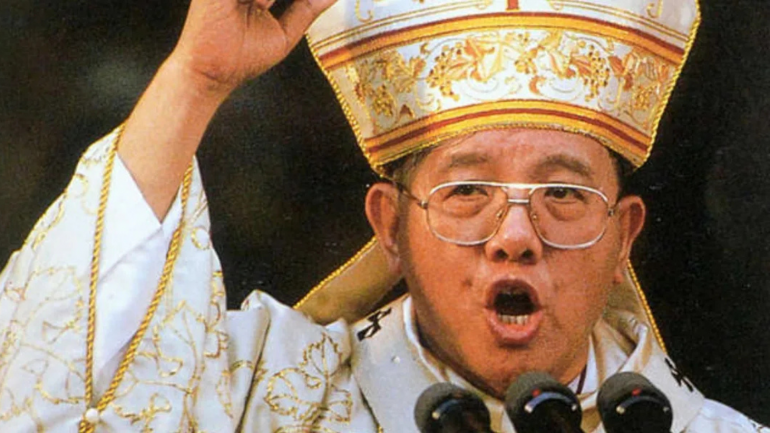Philippines’ Cardinal Sin: The voice that summoned the waves of peaceful EDSA Revolution

The late Jaime Cardinal Sin was appointed coadjutor Archbishop of Jaro in 1972, the same year Ferdinand Marcos, Sr., father and namesake of the sitting president, put the entire Philippines under martial rule. He became full Archbishop of Jaro the following year.
In 1974, two years after Marcos declared martial law, Cardinal Sin was installed as Archbishop of Manila.
State forces shut down seven television stations, more than 200 radio stations, and over a dozen national newspapers after Marcos declared martial law.
The Signs of the Times, a publication by the Association of Major Religious Superiors of the Philippines, and The Communicator, a publication by the Jesuits, were also clamped down.
Marcos announced Proclamation No. 1081, claiming it was the last recourse to slow down and eventually crush the Maoist New People’s Army of the newly founded Communist Party of the Philippines, and the moro secessionists in Mindanao at the time.
But observers viewed his military rule as a blueprint to silence rivals and critics, and hamstring the growing popular dissent among the people as part of his design to perpetuate himself in power.
The late President Ramon Magsaysay crushed Hukbalahap, the guerilla organization of the old Marxist-Leninist Partido Komunista ng Pilipinas during his term without putting the entire country under martial rule.
The 1935 Philippine Constitution allowed a president to two consecutive four-year terms only. Not qualified to run for a third term, Marcos announced Proclamation No. 1081, using the scare of communism and secessionism to justify the imposition of martial law.
Many of the figures thrown by Marcos in prison were not leftists, nor moro separatists, like Senator Jovito Salonga, Senator Jose Diokno, Senator Aquilino Pimentel, Sr., Senator Ninoy Aquino, ABS-CBN chairman emeritus Eugenio Lopez, Sr., Manila Times former publisher Chino Roces, The Philippine Star former publisher Max Soliven, and many more.
Cardinal Sin publicly called on Marcos to stop his military rule, which is held responsible for torture and abuse of 11,103 people, 2,326 killings and disappearances, and arrest and detention of 50,000 people including church workers.
Proclamation 1081 was lifted on January 17, 1981, but his power as dictator essentially continued until he was toppled during the EDSA Revolution in February 1986.
In October 1983, Marcos declared bankruptcy and requested a 90-day moratorium on principal debt.
The economy started to collapse in the 1980s due to spending that relied heavily on debts. In 1984 and 1985, gross domestic product contracted by 7.3 percent, the worst postwar economic performance.
Former Defense Minister Juan Ponce Enrile, and the late Philippine Constabulary Chief Fidel Ramos withdrew their support of Marcos on February 22, 1986.
At this juncture, Cardinal Sin called on the people to support Enrile and Ramos.
In his address to the people on February 22, 1986, which was aired by Radio Veritas, Cardinal Sin spoke:
“My dear people, I wish you to pray because it’s only through prayer that we may solve this problem. This is Cardinal Sin speaking to the people, especially in Metro Manila.
“I am indeed concerned about the situation of Minister [Juan Ponce] Enrile and General [Fidel] Ramos.
“I am calling our people to support our two good friends at the camp. If any of you could be around at Camp Aguinaldo to show your solidarity and your support in this very crucial period when our two good friends have shown their idealism. I would be very happy if you could support them now. I would only wish that violence and bloodshed would be avoided.
“Let us pray to our Blessed Lady to help us in order that we can solve this problem peacefully.”
His address to the people was aired by Radio Veritas, which was still part of Radio Veritas Asia at the time. Radio Veritas separated from Radio Veritas Asia in 1991 to broadcast as a commercial Catholic radio station.
People started to go to EDSA (Epifanio de los Santos Avenue) on February 22. Priests and nuns joined the people.
By February 25, the number of people on EDSA calling for Marcos to step down rose to more than two million. At the time, the country had an estimated population of 56 million.
Corazon Aquino, Marcos’ sole rival in the 1986 snap election and Senator Ninoy Aquino’s widow, became president.
A report by GMA News dated February 25, 2016, said Marcos and his family fled to Hawaii with $717 million in cash and $124 million in deposit slips.
A report by Rappler dated September 29, 2021, said: “As of year-end 2020, the Philippine government has recovered P174.2 billion in Marcos ill-gotten wealth and has earmarked part of it for the farmers through the agrarian reform program and the coco levy trust fund, as well as the compensation of victims of abuses during the martial law dictatorship.”
Cardinal Sin also played a key role in the 2001 EDSA Revolution that toppled President Joseph Estrada, replacing him with Gloria Arroyo, the vice president at that time.
Cardinal Sin was widely recognized for his major role in restoring democracy in the Philippines.
At the start of martial law, 46 of the 79 members of the Catholic Bishops Conference of the Philippines chose to be tolerant of the military rule and would call out the regime only on issues related to church affairs. Only 15 members, who were mostly young, had openly spoken against martial law abuses.
Sin was born on August 31, 1928, in Aklan, home to Boracay Island.
His father, Juan Sin was a merchant of Chinese descent. His mother, Maxima Lachica, a native of Aklan. He was the 14th child among 16.
Cardinal Sin went to St. Vincent Ferrer Seminary. He was ordained a priest in 1954. In 1957, he became the first rector of St. Pius X Seminary – a post he held until 1967.
Pope Paul VI appointed him a member of the College of Cardinals in 1976, four years after Marcos declared martial law. He was the youngest member of the College until 1983.
Cardinal Sin joined the conclave to elect John Paul (Albino Luciani) pope in August 1978. John Paul I died in September of the same year.
Cardinal Sin joined the conclave to elect John Paul II as pope in October 1978.
He made fun of her surname by greeting guests “Welcome to the house of Sin.”
He was conferred 26 honorary doctorates by educational institutions in the Philippines and abroad, including the Pontifical and Royal University of Santo Tomas in Manila, Yale University, Georgetown University, Brandeis University and Boston College.
Cardinal Sin died of renal failure on June 21, 2005, at the age of 76. Former President Arroyo accorded him a state funeral and a period of national mourning. His remains lay in the crypt of Manila Cathedral.








